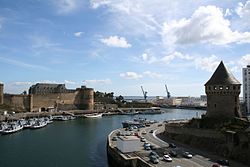| Brittany | |
 | |
Location  | |
Coat of arms and flag  | |
| State | France |
|---|---|
| Capital | Rennes |
| Surface | 27,208 km² |
| Inhabitants | 3.139.000 (2008) |
| Tourism site | |
| Institutional website | |
Brittany (Bretagne, in Breton Breizh) is a region of the France.
To know
The name Brittany derives from that of the Breton people, who settled there fleeing from their native Britain. In fact, Britain and Britain are synonymous.
Brittany is traditionally divided between the coast, called "Armor", traditionally richer and more populated, and the more isolated lands, called "Argoat". In Breton the word armor means "the sea", and argoat "the forest, the land, the countryside".
The Breton landscape changes at every moment, alternating strength and fragility and offering suggestive views. Along the coast, the wild cliffs overlooking the sea give way to the rounded curves of the dunes. When the moor slopes towards the valley, you can admire escarpments characterized by the bocage, a typical rural landscape that characterizes northern France.
Geographical notes
The territory of the region borders on that of the Lower Normandy to the north-east and of the Pays de la Loire to the southeast. The southern and western coasts are washed by the Atlantic Ocean, the northern ones by the English Channel, the western ones by the "Sea of Iroise", in fact it starts from the ocean around the islands of Sein / Enez Sun and Ouessant / Enez Eusa.
The highest mountains in Brittany culminate at 302 m (Menez Bre), 330 m (Ménez-Hom / Menez-C'homm), 380 m (Menez Mikael) 384 m (Tuchen Kador, Roc'h Trevezel).
When to go
The climate of Brittany is heavily influenced by the Atlantic Ocean, resulting in a large amount of precipitation (especially on the western end) and mild temperatures throughout the year, despite the high latitude.
Taking Brest for example, the monthly minimums throughout the year are between 4 and 13 ° C, while the maximums are between 9 and 20 ° C.
Spoken languages
The official language is French, while the regional languages are Breton and Rooster.
It is also divided between east and west according to the so-called linguistic frontier: in the west, in Lower Brittany, Breton was historically spoken until the end of the nineteenth century (and still today most of the practitioners of the Breton language are located in the west of the peninsula) while in eastern Brittany, Haute-Brittany, Gallic or French was historically spoken, as in Nantes or Rennes.
Territories and tourist destinations
Brittany is administratively divided into four departments:
- Côtes-d'Armor (or Aodoù-an-Arvor) —
- Finistère (or Penn-ar-Bed) —
- Ille-et-Vilaine (or Ill have Gwilen) —
- Morbihan —
Urban centers
- Rennes - Capital of the region.
- Auray
- Brest - Located on the western edge of continental Europe and home to the main French military naval base.
- Carnac
- Concarneau
- Crozon
- Dinan
- Dinard - Seaside center opposite Saint-Malo.
- Lorient
- Montfort-sur-Meu - Located in the Ille-et-Vilaine department.
- Pont-Aven
- Pontivy
- Quiberon - Located in the southern part of the Quiberon peninsula.
- Quimper
- Saint-Brieuc
- Saint-Malo
- Vannes
- Vitré - For the richness of its historical and artistic heritage it has obtained the recognition of "city of art and history" by the French Ministry of Culture.
How to get
By plane
Brittany can be reached with Air France-KLM flights, departing from the main Italian cities, with a stopover in Lyon and arriving in Rennes, Quimper and Brest. With Air France-KLM there is also the possibility of a direct flight from Milan Malpensa to Nantes.
By car
Coming fromItaly, Milan is far from Rennes about 1154 km. Take the A4-A5 to Aosta-Mont Blanc tunnel, then the A40 to Macon, the A6 to Joigny, the N60 to Orléans, the A10 for Chartres, the A11 for Le Mans and finally the A81 to Rennes.
On the train
Brittany can be reached by train with the TGV, the French high-speed train, which can be taken from Charles de Gaulle airport or from the train station. Paris Montparnasse. From Paris it takes about 2 hours to reach Rennes (three hours from Charles de Gaulle), 4 hours to Brest and Quimper (if you leave from Charles de Gaulle you have to change in Rennes). -line or at some retailers, you can benefit from cheaper rates.
How to get around
By car
Brittany has a road service consisting of two main axes that connect it with the north and the south, the Estuaires motorway (A 84 and A 83), and coming from the east there is the Oceane motorway (A11). As soon as you cross the borders of the region, you enter the Breton road network, entirely free.
